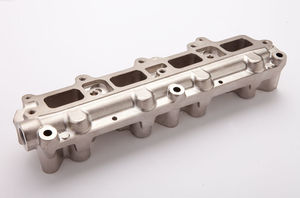

- Products
- Catalogs
- News & Trends
- Exhibitions
Electrolytic nickel plating aluminumISO 14001high phosphorus






Add to favorites
Compare this product
Characteristics
- Type
- electrolytic
- Substrate
- aluminum
- Certifications
- ISO 14001
- Other characteristics
- high phosphorus
Description
Nickel is the all-rounder of surface technology. With its diverse properties, nickel is one of the most important and frequently used coatings because it is almost universally applicable. Nickel layers are characterised by high resistance to atmospheric corrosion, many acids, sea water and alkali solutions. Chemical resistance is increased by the formation of an oxide layer. Nickel is also valued for its tribological benefits, such as wear resistance and slipperiness.
Its silvery white look that has a slightly yellowish tone, which can be adjusted from matt to glossy, is ideal for decorative applications.
Depending on the requirements, nickel can be deposited electrochemically or chemically. Both coating processes generate their own specific properties, which do not compete with each other, but complement each other in technical and economic terms.
Glossy nickel
Glossy nickel (mirror gloss) is preferred for highly decorative surfaces and is used as an intermediate layer for glossy chrome plating, which can be changed back to matt with intermediate polishing. Layers are used very often in the sanitary industry. At 650 HV, nickel layers are relatively hard and tough.
Sulfamate nickel
Sulfamate nickel is a purely technical nickel process in which very ductile nickel layers are deposited (due to the low internal stresses), which can be easily reshaped. Typical applications are rivets and sheet metal parts that are then crimped.
Related Searches
- Anodic oxidation
- Aluminum anodic oxidation
- Anodic oxidation with coloring
- Nickel plating
- Painting
- Painting on metal
- Powder coating
- Hard anodizing
- Zinc-plating
- Galvanizing
- Automotive anodic oxidation
- Hot dip galvanizing
- Medical anodizing
- Metallization
- Chrome plating
- Industrial anodizing
- High phosphorus nickel plating
- Titanium anodizing
- Steel nickel plating
- Aluminum nickel plating
*Prices are pre-tax. They exclude delivery charges and customs duties and do not include additional charges for installation or activation options. Prices are indicative only and may vary by country, with changes to the cost of raw materials and exchange rates.



